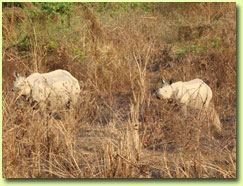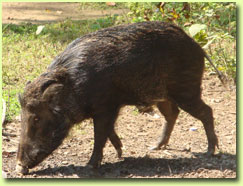About Chitwan
BACKGROUND
 Chitwan National Park (CNP) has long been one of the country treasures of natural wonders. The park is situated in south central Nepal, covering 932sq. km. in the subtropical lowlands of the inner Terai. The area comprising the Tikauli forest-from Rapti river to the foothills of the Mahabharat-extending over an area of 175sq. km. was declared Mahendra Mriga Kunj (Mahendra Deer Park) by the late King Mahendra in 1959. In 1963, the area south of Rapti River was demarcated as a rhinoceros sanctuary. The area was gazette as the country's first national Park in 1973. Recognizing its unique ecosystems of international signification, UNESCO declared RCNP a World Heritage Site in 1984.
Chitwan National Park (CNP) has long been one of the country treasures of natural wonders. The park is situated in south central Nepal, covering 932sq. km. in the subtropical lowlands of the inner Terai. The area comprising the Tikauli forest-from Rapti river to the foothills of the Mahabharat-extending over an area of 175sq. km. was declared Mahendra Mriga Kunj (Mahendra Deer Park) by the late King Mahendra in 1959. In 1963, the area south of Rapti River was demarcated as a rhinoceros sanctuary. The area was gazette as the country's first national Park in 1973. Recognizing its unique ecosystems of international signification, UNESCO declared RCNP a World Heritage Site in 1984. In 1996, an area of 750 sq.km surrounding the park was declared a buffer zone which consist of forests and private land. The park and the local people jointly initiate community development activities and manage natural resources in the buffer zone. Government of Nepal has made provision of plowing back 30-50 percent of the park revenue for community development in the buffer zone.

CLIMATE
The park has range of climatic seasons, each offering a unique experience. October through February with an average temperatures of 25dc offer an enjoyable climate. From March to June temperatures can reach as high as 43dc. The hot humid days give way to the monsoon season that typically lats from late June until September, River become flooded and roads are imposible.In late January, local villager, local villagers are allowed to cut thatch graces to meet their needs, which offers a better viewing of wildlife to visitors. Also between September and November, and February and April, migratory birds join the residential birds and create spectacular bird watching opportunities. While the monsoon rains bring lush vegetation, most trees flower in late winter. The palash tree known as "flame of the forest" and silk cotton tree have spectacular crimson flowers that can be seen from a distance.

FEATURES
The park consists of a diversity of ecosystems, including the Churia hills, ox-bow lakes, and the flood plains of the Rapti, Reu and Narayani Rivers. The churia hills rise slowly towards the east from 150m. to more than 800 m. The western portion of the park is comprised of the lower but more rugged someshwor hill. The park shares its eastern boundary with the Parsa Wildlife Reserve.The Chitwan valley consists of tropical and subtropical forests. Sal forests cover 70 percent of the park. Sal leaves are used locally for plates in festivals and religious offerings.
Grasslands cover 20 percent of the park. There are more than 50 different types of grasses. Including the elephant grass (Saccharum spp.) renowned for its immense height. It can grow up to 8m in height. The shorter grasses (Imperata spp.) are used for roof thatching, and mats, rope and paper making. The park is home to more than 50 mammal species, over 525 birds, and 55 amphibians and reptiles. The endangered fauna in the park are.

MAMMALS AND REPTILES
One-horned rhinoceros, Gaur, Royal Bengal tiger, wild elephant, four horned antelope, Pangolin, golden monitor lizard, python, etc.BIRDS
Bengal florican, lesser florican, giant hornbill, black stork, white stork etc.Tharus are the main indigenous ethnic groups in Chitwan. They are well known for their resistance to Malaria. Traditionally they are farmers and practice their own unique tribal culture. A stroll or a ride through the Tharu Village will provide an opportunity to see their traditional farming and relics. Traditional Tharu stick dance gives an insight into their culture.

Home | Introduction | Tariff | Reservations | Activities | Hotel Fact Sheet | Photogallery | Contact us

